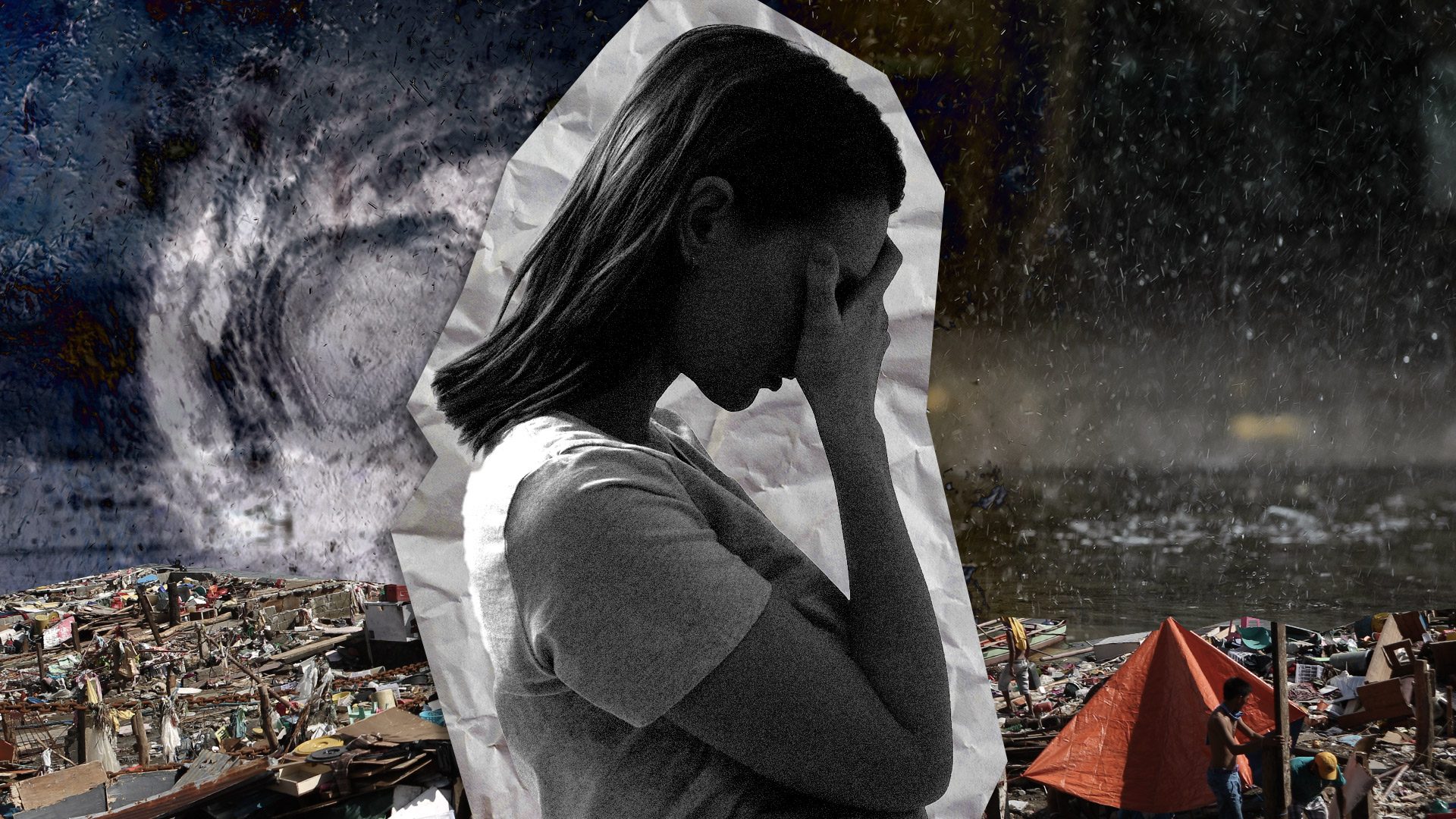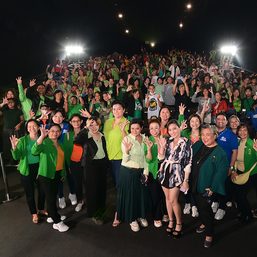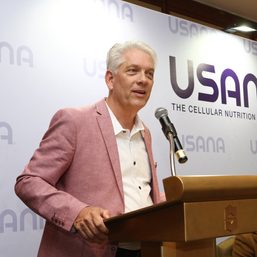SUMMARY
This is AI generated summarization, which may have errors. For context, always refer to the full article.

MANILA, Philippines – The first time Gabes Torres ever feared for her life, she was surrounded by screaming winds during Typhoon Milenyo (Xangsane).
She had seen her fair share of typhoons before that, as every Filipino has: according to some estimates, the Philippines is the most storm-exposed country on Earth, hit by about 20 tropical cyclones a year.
But Milenyo felt different to the then-14-year-old, who was living in Los Baños at the time.
“We had neighbors whose roofs just flew off,” she said 17 years later, sitting at the dinner table in her apartment in Manila. “That really marked me as a teenager, not knowing if our house was going to collapse.”
Torres’ family was left without power for weeks after the storm passed, and they relied on vinegar-based meals to make sure that their food wouldn’t spoil without refrigeration. Still, in many ways, they knew they were lucky: no one in Torres’ family was among the nearly 200 casualties of the storm, and they didn’t lose their roof or their home. And for all the terror of the time, Torres remembers the way that community cared for one another, checking in and making sure each household had what they needed.
Even so, memories of the storm have followed Torres for years. As an adult, she felt a familiar anxiety pricking years later, even when faced with a much milder storm: ‘Do I have enough food to get through the rest of the week? Do I have candles and flashlights? Am I prepared?’
“I experienced that anxiety like my body was remembering that time when I was 14,” she said. “Even though I was reasoning with myself, ‘Gabes, you’re in a different time and place,’ it made me realize that my body kept a record of what happened years ago in 2006.”
Torres, a licensed psychotherapist, now identifies that experience as indicative of climate anxiety or trauma – psychological distress attributed to the climate crisis or its impacts. Though it’s a fairly new area of study, especially in the context of the Philippines, a 2021 paper about climate anxiety published in The Lancet found that young people in the Philippines were the most worried of any country surveyed, and that worry impacted daily functioning for 74% of survey respondents.
The Philippines is, according to some accounts, the most climate-vulnerable nation in the world. Though typhoons have always been a part of life in the archipelago, climate change is making them more intense.
“We are experiencing stronger typhoons than before, and we can attribute it to the warming of the sea surface temperature and the warming of the atmosphere,” said Esperanza Cayanan of PAGASA, the Philippines’ national meteorological agency, in 2020.
Heat waves, rising sea levels, more intense droughts, declining rice yields, and the increase of mosquito-borne illnesses like dengue are just a few of the other climate impacts that have or will hit the Philippines as global temperatures continue to rise.
Challenges to access
Torres’ experience isn’t unusual. Jon* was a 9-year-old living in Cainta when Tropical Storm Ondoy (Ketsana), the most destructive typhoon to ever make landfall in Manila, hit in 2009. His home was flooded with six feet of water, leaving the living room and first floor covered in mud when the water receded. Outside, a 12-foot wall was knocked down by the water, smashing the family’s car with a loud crash. Nearly 15 years later, he describes Ondoy as the spark that ignited the “ticking time bomb” of his mental health issues.
“Ever since that, every single day was perpetual anxiousness,” he said. He began obsessively checking the weather satellite map every morning when he woke up to monitor storms. At school, he was constantly looking out the windows.
“If there was a massive cloud, I’d essentially be done for the rest of the day [because] I’d be freaking out,” he said.
As a young adult, he eventually connected with therapists who helped him identify his obsessive thinking patterns and learn to manage them. But access to that kind of care is a privilege not afforded the majority of Filipinos.
Though the landmark Mental Health Law enshrining mental health as a national priority was finally signed in 2018, stigmas and misperceptions remain. For instance, “it’s not uncommon to hear family members say that you just need to pray more” when you share about being depressed or anxious, said Torres.
Plus, care remains expensive. Michelle*, an organizer with Youth Advocates for Climate Action Philippines (YACAP), whose anxiety and depression are exacerbated by climate impacts, said she spends 20% of her income on psychiatric care – and that’s with her parents covering the cost of medication. That she can afford care at all is a privilege, she said. The fisherfolk, farmers, urban poor, and anyone else disproportionately impacted by climate disasters are often the least likely to be able to access or afford care.
For environmental defenders, there can also be safety concerns. Climate activists who experience climate anxiety might feel they can’t share openly about their actions with therapists, since therapists may report them to the government as having violated the anti-terror law – a scenario that’s played out more than once in the community of climate activists seeing therapists, said Torres.
This reporting can result in activists being red-tagged, or labeled communist rebels or terrorists. Red-tagging can have serious safety implications, as it “strips the victims of the protections of the law” and is often a precursor to violent attacks or human rights violations, according to reporting from Human Rights Watch.
Finding the kind of therapists who won’t endanger their clients by reporting them is difficult considering there are just three mental health professionals for every 100,000 Filipinos, which makes it hard to get mental health support of any kind, much less climate-specific support.
“I have some colleagues who get all excited about the novel thing that needs to be done for climate anxiety,” said Renzo Guinto, director of the planetary and global health program at St. Luke’s Medical Center in Manila. “First and foremost, we just need to have a well-functioning mental healthcare system.”
‘Eco-anxiety’
The global conversation about climate change’s influence on mental health is new enough that many people haven’t made the connection yet – a problem that may be exacerbated in the Philippines by the fact that much of the early research has flowed from and focused on Europe and North America.
Even the most commonly recognized catchall descriptor, “eco-anxiety,” is an English term. This combination of factors has perhaps fueled the speculation from some in the Global North that climate anxiety is an “overwhelmingly white phenomenon,” a conclusion that psychologist AJ Sunglao firmly refutes.
“Even if you don’t have the exact language for it, people will know the feeling,” he said of climate anxiety in the Philippines. “It’s just that we might not be talking about it in ways that we can recognize with each other yet.”
Sunglao, Guinto, and Torres agree that properly addressing climate feelings in the Philippines might necessitate new terminology to discuss the issue, and all three emphasize the importance of adopting a decolonial approach to mental health care.
“We can’t just stop [climate anxiety] based on Western intervention, hoping that it will work here. We need to take into account our cultural distinctives,” said Guinto. He’s spearheading further research on the mental health impacts of climate change on Filipinos in the hopes that better data will support effective action moving forward.
Sunglao imagines the future of climate anxiety care in the Philippines will mean moving away from a one-on-one therapy approach, which isn’t feasible when there are only a few thousand total trained mental health professionals in the country. Instead, he envisions community- or group-based interventions, perhaps following the model of the Friendship Bench, a program pioneered in Zimbabwe that trains lay people to serve as mental health supports within their own communities.
Torres is trying to put some of those ideas into practice. In 2022, when a number of activists were arrested after protesting in solidarity with farmers demanding agrarian land reform in Tarlac, Torres began offering pro bono services to youth activists whom she described as “traumatized” by the event. She recruited other mental health professionals to help, and they’ve continued to offer free care whenever possible to climate organizers who have mental health flare-ups. Her long-term dream is to establish networks of community care that function a bit like group therapy.
Ultimately, it will take a suite of solutions to fight climate anxiety in the Philippines, from collectivist and decolonial approaches to mental health care to the activism that Michelle of YACAP said helps her channel feelings into action.
“Our anger when we’re alone doesn’t amount to anything, but our anger when we collectivize? There’s power there,” she said.
But none of that should overshadow the fact that the problem isn’t on individual Filipinos, or therapists, to solve, according to Guinto. Climate change and its mental health implications are here and need to be dealt with, he said, but there’s a “need for mental health professionals to actually advocate for more upstream changes” to the global systems that have created the climate crisis in the first place.
“Fundamentally, we need to find a way to stop climate change,” he said. “Then we will be able to prevent all the negative mental health effects.” – Rappler.com
*Last names have been omitted to protect privacy.
Whitney Bauck is an independent climate and environment reporter and a fellow at the Solutions Journalism Network. Whitney grew up in Manila, Philippines, and is currently based in Brooklyn, New York. This story was co-published with US-based climate and culture magazine Atmos, with support from the Solutions Journalism Network.
Add a comment
How does this make you feel?












![[OPINION] LGBT, mental health, and why Pride March is there](https://www.rappler.com/tachyon/2024/06/lgbt-mental-health-june-11-2024.jpg?resize=257%2C257&crop_strategy=attention)
![[Free to disagree] Ending victimhood](https://www.rappler.com/tachyon/2024/05/TL-Ending-victimhood-May-20-2024.jpg?resize=257%2C257&crop_strategy=attention)





There are no comments yet. Add your comment to start the conversation.